Trichiini
The Trichiini are a tribe of the scarab beetle family (Scarabaeidae), though historically they were often classified as a subfamily, Trichiinae.[1] The conspicuous bee beetles (Trichius) are probably the best-known genus in Europe.
| Trichiini | |
|---|---|
 | |
| Osmoderma scabra of the Osmodermatina | |
| Scientific classification | |
| Kingdom: | |
| Phylum: | |
| Class: | |
| Order: | |
| Superfamily: | |
| Family: | |
| Subfamily: | |
| Tribe: | Trichiini Fleming, 1821 |
| Subtribes | |
|
Cryptodontina | |
| Synonyms | |
|
Trichiinae (see text) | |
They vary in size from 6 to 65 mm and can be distinguished from Cetoniini by having covered epimeres, and lateral edges of the elytra which are not trimmed.
The adults feed on sugar-rich secretions of stems, leaves, fruits and flowers of different plants. Most larvae develop in rotten wood.
Genera
Subtribus Cryptodontina
- Coelocorynus Kolbe, 1895
- Cryptodontes Burmeister, 1847
Subtribus Incaina
- Archedinus Morón & Krikken, 1990
- Coelocratus Burmeister, 1841
- Golinca Thomson, 1878
- Inca Lepeletier & Serville, 1828
- Pantodinus Burmeister, 1847
Subtribus Osmodermatina
- Osmoderma Lepeletier & Serville, 1825
- Platygeniops Krikken, 1978
Subtribus Platygeniina
- Platygenia MacLeay, 1819
Subtribus Trichiina
- Agnorimus Miyake et al., 1991
- Apeltastes Howden, 1968
- Brachagenius Kraatz, 1890
- Calometopidius Bourgoin, 1917
- Calometopus Blanchard, 1850
- Campulipus Kirby, 1827
- Chaetodermina Heller, 1921
- Clastocnemis Burmeister, 1840
- Corynotrichius Kolbe, 1891
- Dialithus Parry, 1849
- Diploa Kolbe, 1892
- Diploeida Péringuey, 1907
- Elpidus Péringuey, 1907
- Endoxazus Kolbe, 1892
- Epitrichius Tagawa, 1941
- Eriopeltastes Burmeister, 1840
- Giesbertiolus Howden, 1988
- Glaphyronyx Moser, 1924
- Gnorimella Casey, 1915
- Gnorimus Lepeletier & Serville, 1825
- Incala J. Thomson, 1858
- Incalidia Janson, 1907
- Lasiotrichius Reitter, 1898
- Liotrichius Kolbe, 1892
- Myodermides Ruter, 1964
- Myodermum Burmeister, 1840
- Paragnorimus Becker, 1910
- Paratrichius Janson, 1881
- Peltotrichius Howden, 1968
- Pileotrichius Bourgoin, 1921
- Polyplastus Janson, 1880
- Stegopterus Burmeister, 1840
- Stripsipher Gory & Percheron, 1833
- Trichiomorphus Bourgoin, 1919
- Trichiotinus Casey, 1915
- Trichius Fabricius, 1787 – bee beetles
- Trigonopeltastes Burmeister, 1840
- Xiphoscelidus Péringuey, 1907
gollark: Why not -145 instead?
gollark: ++remind 3d gueß
gollark: I always submit my guesses several hours before the deadline.
gollark: My RNG says *I* did #7.
gollark: As I wrote this entry, I know about it.
References
- Bouchard, P.; Bousquet, Y.; Davies, A.; Alonso-Zarazaga, M.; Lawrence, J.; Lyal, C.; Newton, A.; Reid, C.; Schmitt, M.; Ślipiński, A.; Smith, A. (2011). "Family-group names in Coleoptera (Insecta)". ZooKeys. 88: 1–972. doi:10.3897/zookeys.88.807. PMC 3088472. PMID 21594053.
External links
| Wikimedia Commons has media related to Trichiini. |
- List of the Oriental Trichiine Scarabs (with key)
- Evans, Arthur H. Generic Guide to New World Scarabs
- Inca clathrata
- Trichius fasciatus
This article is issued from Wikipedia. The text is licensed under Creative Commons - Attribution - Sharealike. Additional terms may apply for the media files.